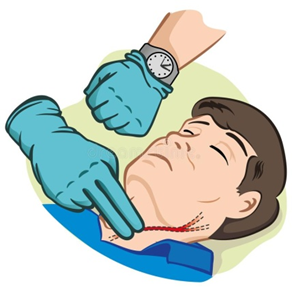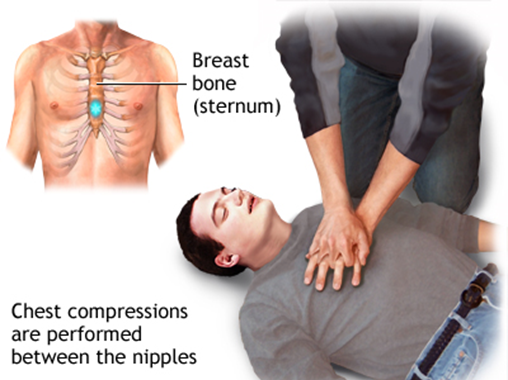#14 Every Person Must know How to do CPR
CPR is a procedure done to restart a heart of a person when it suddenly stops. This procedure should be started as early as possible when you see no pulse (carotid pulse) and no respiration in the victim
(NOTE: The person should not have any other emergencies such as bleeding). CPR is done by providing chest compressions and rescue breaths in a constant ratio. Proper technique and help at the earliest can save a life.
Checking
for the carotid pulse
The ratio of giving CPR is 30:2,
in which 30 is the number of chest
compression and 2 is the number of
rescue breath given by the rescuer. The ratio of 30:2 is when there is only one
rescuer per victim. If there are two rescuers per victim then the ratio changes
as 15:2, in which 15 is the number of chest compression
and 2 is the number of rescue breath
given by the rescuer.
Before starting CPR, check:
- Is the environment safe for the person?
- Is the person conscious or unconscious?
- If the person appears unconscious, tap or
shake his or her shoulder and ask loudly, "Are you OK?"
- If the person doesn't respond and you're
with another person who can help, have one person call 108 or the local
emergency number and get the AED, if one is available. Have the other
person begin CPR.
- If you are alone and have immediate
access to a telephone, call 108 or your local emergency number before
beginning CPR. Get the AED if one is available.
- As soon as an AED is available,
deliver one shock if instructed by the device, then begin CPR.
The American Heart Association uses the letters C-A-B to help people remember the order to perform the steps of CPR.
C: Compressions
A: Airway
B: Breathing
CHEST COMPRESSION
The method of chest compression for adults and children is:
1. Place the heel of the palm of the
rescuer’s non-dominant hand and interlock the finger or the wrist with the
dominant hand.
2. Compress the chest not more than 1.5
to 2 inches according to the age group.
The method
of chest compression for a baby is:
1. Place the two fingers of the rescuer’s
non-dominant hand and interlock the wrist with the dominant hand.
2. Compress the chest not more than 1 inch.
While giving chest compression the rescuer’s elbow should not fold, the power generation for compression should be from his or her shoulder or upper trunk of the body.
RESCUE BREATHING
Rescue breath blowing air
to the mouth or nose of the victim to provide him with oxygen, as there is no
breathing. Rescue breath is given 2 in number after completing 30 chest
compressions. There are three techniques to provide rescue breath;
AUTOMATED EXTERNAL DEFIBRILLATOR (AED)
FIRST AID GUIDE IN PROVIDING CPR AND USING AN AED
1.
CHECK
FOR HAZARDS- check and neutralize hazards to victim,
yourself and bystanders before treating victim check for:
·
Falling objects
·
Incoming traffic
·
Fire and fumes
·
Electricity
·
Spilled chemicals
2.
CHECK
LEVEL OF RESPONSE-
·
Check whether victim is conscious or
not
·
Ask them to open their eyes. Call
their name (if known)
·
Gently shake victim’s shoulders
·
Do not move victim unless there is a
hazard.
3.
CALL
FOR HELP-
·
You should call emergency services
immediately.
·
If you are alone, call for help before
responding, if you are with someone, ask other person to call while you respond
·
Be ready to provide information
regarding your location and the incident.
4.
CHECK
AIRWAY-
·
Check airway of an unresponsive victim
·
Open victim’s mouth and look for
obstruction
·
Free the tongue by lifting chin and tilting
head back
·
If victim has suffered a neck or
spinal injury, do not move their head.
5.
CHECK
FOR BREATHING-
·
Look at the victim’s chest- is it
rising and falling
·
Listen for breathing- place your ear
near victim’s face
·
Feel for moving air on your cheek when
near victim’s nose and mouth.
·
Place one hand on their stomach to
feel it rise and fall. This indicates normal breathing.
A.
If the victim is breathing put them
into recovery position.
B.
If the victim is not breathing, call
for medical assistance immediately. Start doing full cardiopulmonary
resuscitation and then get a defibrillator.
6. PERFORMING CPR-
Provide chest compression and rescue breath
7. AED DEFIBRILLATION-
·
Remove any sharp objects from victim’s
pockets.
·
Secure the hands of the victim
·
Turn on the AED and follow the
instructions.
Reference:
1. GK Pal
book of anatomy and physiology
2.
https://pubmed.ncbi.nlm.nih.gov
Prepared by
Dept of
Medicine PMA








Comments
Post a Comment